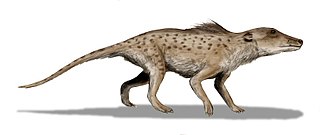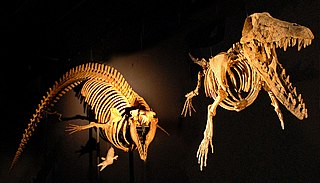Related Research Articles

Rodhocetus is an extinct genus of protocetid early whale known from the Lutetian of Pakistan. The best-known protocetid, Rodhocetus is known from two partial skeletons that taken together give a complete image of an Eocene whale that had short limbs with long hands and feet that were probably webbed and a sacrum that was immobile with four partially fused sacral vertebrae. It is one of several extinct whale genera that possess land mammal characteristics, thus demonstrating the evolutionary transition from land to sea.

Pakicetidae is an extinct family of Archaeoceti that lived during the Early Eocene in Pakistan.

Plesiadapis is one of the oldest known primate-like mammal genera which existed about 58–55 million years ago in North America and Europe. Plesiadapis means "near-Adapis", which is a reference to the adapiform primate of the Eocene period, Adapis. Plesiadapis tricuspidens, the type specimen, is named after the three cusps present on its upper incisors.

Pakicetus is an extinct genus of amphibious cetacean of the family Pakicetidae, which was endemic to Pakistan during the Eocene, about 50 million years ago. It was a wolf-like animal, about 1 metre to 2 metres long, and lived in and around water where it ate fish and other small animals. The vast majority of paleontologists regard it as the most basal whale, representing a transitional stage between land mammals and whales. It belongs to the even-toed ungulates with the closest living non-cetacean relative being the hippopotamus.

Archaeoceti, or Zeuglodontes in older literature, is a paraphyletic group of primitive cetaceans that lived from the Early Eocene to the late Oligocene. Representing the earliest cetacean radiation, they include the initial amphibious stages in cetacean evolution, thus are the ancestors of both modern cetacean suborders, Mysticeti and Odontoceti. This initial diversification occurred in the shallow waters that separated India and Asia 53 to 45 mya, resulting in some 30 species adapted to a fully oceanic life. Echolocation and filter-feeding evolved during a second radiation 36 to 35 mya.

Ichthyolestes is an extinct genus of archaic cetacean that was endemic to Indo-Pakistan during the Lutetian stage. To date, this monotypic genus is only represented by Ichthyolestes pinfoldi.

Mesonychidae is an extinct family of small to large-sized omnivorous-carnivorous mammals. They were endemic to North America and Eurasia during the Early Paleocene to the Early Oligocene, and were the earliest group of large carnivorous mammals in Asia. They are not closely related to any living mammals. Mesonychid taxonomy has long been disputed and they have captured popular imagination as "wolves on hooves," animals that combine features of both ungulates and carnivores. Skulls and teeth have similar features to early whales, and the family was long thought to be the ancestors of cetaceans. Recent fossil discoveries have overturned this idea; the consensus is that whales are highly derived artiodactyls. Some researchers now consider the family a sister group either to whales or to artiodactyls, close relatives rather than direct ancestors. Other studies define Mesonychia as basal to all ungulates, occupying a position between Perissodactyla and Ferae. In this case, the resemblances to early whales would be due to convergent evolution among ungulate-like herbivores that developed adaptations related to hunting or eating meat.

Remingtonocetus is an extinct genus of early cetacean freshwater aquatic mammals of the family Remingtonocetidae endemic to the coastline of the ancient Tethys Ocean during the Eocene. It was named after naturalist Remington Kellogg.

Didymictis is an extinct genus of placental mammals from extinct subfamily Didymictinae within extinct family Viverravidae, that lived in North America and Europe from the late Paleocene to middle Eocene.
Artiocetus is an extinct genus of early whales belonging to the family Protocetidae. It was a close relative to Rodhocetus and its tarsals indicate it resembled an artiodactyl.

Remingtonocetidae is a diverse family of early aquatic mammals of the order Cetacea. The family is named after paleocetologist Remington Kellogg.
The Qasr el Sagha Formation is a geological formation located in Egypt. The formation is part of the Wadi El Hitan World Heritage Site. The Qasr el Sagha Formation overlies the Birket Qarun Formation and is overlain by the Gebel Qatrani Formation. The sandstones and shales of the formation were deposited in a deltaic to shallow marine environment. It dates to the Late Eocene.

Palaeonictis is an extinct predatory mammal belonging to the family Oxyaenidae, existing from the late Paleocene to the early Eocene in Europe and North America.
The Willwood Formation is a sedimentary sequence deposited during the late Paleocene to early Eocene, or Clarkforkian, Wasatchian and Bridgerian in the NALMA classification.
Wyonycteris is a genus of small mammals that existed in the late Paleocene and early Eocene epochs. The type species is Wyonycteris chalix, which lived in Wyoming during the Clarkforkian North American Land Mammal Age of the Paleocene and was originally proposed to be an early form of insectivorous bat. Later re-examination of the material has put this alliance in doubt, and the genus has instead been proposed as belonging to the subfamily Placentidentinae, within the family Nyctitheriidae. Similar fossil material of the same time period found in Europe was later discovered and described as new species, Wyonycteris richardi.
Chiromyoides is a small plesiadapid primatomorph that is known for its unusually robust upper and lower incisors, deep dentary, and comparatively small cheek teeth. Species of Chiromyoides are known from the middle Tiffanian through late Clarkforkian North American Land Mammal Ages (NALMA) of western North America, and from late Paleocene deposits in the Paris Basin, France.
Azygonyx was a small tillodont mammal, likely the size of a cat to raccoon, that lived in North America during the Paleocene and Eocene in the early part of the Cenozoic Era. The only fossils that have been recovered are from the Willwood and Fort Union Formations in the Bighorn Basin of Wyoming, United States, and date to the Clarkforkian to Wasatchian, about 56 to 50 million years ago. Fifty-six collections that have been recovered thus far include the remains of Azygonyx. Azygonyx survived the Paleocene Eocene Thermal Maximum along with other mammals like Phenacodus and Ectocion, both of which were ground-dwelling mammals. Azygonyx probably was a generalist terrestrial mammal that may have roamed around the ground, but was also capable of climbing trees.

The Andrewsiphiinae is an extinct subfamily of early whales of the family Remingtonocetidae. Thiewessen & Bajpai (2009) proposed the clade when Andrewsiphius and Kuchicetus were accepted as separate genera. Kuchicetus was originally synonymized with Andrewsiphius in 2001 by Gingerich et al., but later authors, however, still accept both as separate genera.

Sunil Bajpai is the Chair Professor of Vertebrate Paleontology in the Department of Earth Sciences, Indian Institute of Technology Roorkee. He also served as the director of the Birbal Sahni Institute of Palaeosciences from January 2013 to July 2018.

Palaeonictinae is a extinct subfamily of oxyaenids from the late Paleocene to early Eocene of Europe and North America.
References
- 1 2 "Philip D. Gingerich" . Retrieved 2009-02-09.
- ↑ "Philip D. Gingerich Ph.D." Expert List. University of Michigan. Archived from the original on 2009-07-14. Retrieved 2009-02-09.
- ↑ Tim Arango (19 May 2009). "Seeking a Missing Link, and a Mass Audience". New York Times.
- ↑ Mueller, Tom (March 2013). "Whale Evolution". National Geographic Magazine.
- ↑ "Henry Russel Award". University of Michigan. 2009-06-09. Retrieved 2009-06-12.
- ↑ "ASM Awardees". American Society of Mammalogists. Archived from the original on 2004-03-23. Retrieved 2009-06-12.
- ↑ "The Paleontological Society: Awardees". Archived from the original on 2002-10-21. Retrieved 2009-06-12.
- ↑ "Research on Rates of Evolution". University of Michigan. 2007. Retrieved 2009-02-09.
- 1 2 Gingerich PD (May 2006). "Environment and evolution through the Paleocene-Eocene thermal maximum". Trends Ecol. Evol. 21 (5): 246–53. doi:10.1016/j.tree.2006.03.006. PMID 16697910.
- ↑ Aziz, HA; Hilgen FJ; Luijk GMv; Sluijs A; Kraus MJ; Pares JM; Gingerich PD (2008). "Astronomical climate control on paleosol stacking patterns in the upper Paleocene–lower Eocene Willwood Formation, Bighorn Basin, Wyoming". Geology. 36 (7): 531–534. Bibcode:2008Geo....36..531A. doi:10.1130/G24734A.1. hdl: 1874/385781 .
- ↑ "Research on Paleocene-Eocene Mammals and the PETM or Paleocene-Eocene Thermal Maximum". University of Michigan. 2009. Retrieved 2009-02-09.
- ↑ "Research on the Origin and Early Evolution of Whales (Cetacea)". University of Michigan. 2009. Retrieved 2009-02-09.
- ↑ Gingerich, PD (2007). "Early evolution of whales: a century of research in Egypt" (PDF). In Fleagle JG, Gilbert CC (ed.). Elwyn Simons: A Search for Origins. Springer. pp. 107–124. Retrieved 2009-02-09.
- ↑ Gingerich, PD (2008). "Basilosaurus cetoides". Encyclopedia of Alabama. 1386: 1–3. Retrieved 2009-02-09.
- ↑ "Research on the Origin and Early Evolution of Primates". University of Michigan. 2009. Retrieved 2009-02-09.
- ↑ Smith T, Rose KD, Gingerich PD (July 2006). "Rapid Asia–Europe–North America geographic dispersal of earliest Eocene primate Teilhardina during the Paleocene–Eocene Thermal Maximum". Proceedings of the National Academy of Sciences. 103 (30): 11223–7. Bibcode:2006PNAS..10311223S. doi: 10.1073/pnas.0511296103 . PMC 1544069 . PMID 16847264.